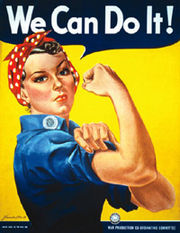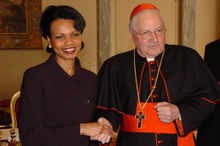Rise of a Woman in America: Difference between revisions
m (sp) |
(No difference)
|
Revision as of 16:26, 4 May 2007
|
In June 1933, William Branham experienced a series of 7 prophetic visions. In the sixth vision, a woman rose to great power in America. William Branham was not sure whether the "Woman" in this vision was a physical woman, or a religious power such as the Catholic Church. This article addresses both the rise of women, and the rise of the Catholic Church in America. This vision is being fulfilled.
1958 retelling of the 1933 prophesy<playmp3>Why Are We Not A Denomination, 1958|woman rising 58-0927.mp3</playmp3>
See the sermon Why Are We Not A Denomination for the full text of this prophecy.
Taken from Chapter 9 of the Church Ages Book (the Laodicean Church Age), William Branham Rise of a Woman in AmericaIn 1933, Frances Perkins became the first female member of the United States Cabinet, and the original film version of King Kong, starring Fay Wray, premiered in New York City. In 2006, Nancy Pelosi became the first speaker of the house of Congress, and second in the line of Presidential succession after the Vice President. Only a year before, Naomi Watts had starred in a remake of the film King Kong. Between 1933 and 2006, women increased their presence in Blue Collar jobs, broke the corporate glass ceiling, and shattered the stained-glass ceiling of most religions in America. On January 20, 2007, Hillary Clinton announced the formation of a presidential exploratory committee, with the intention to become a Candidate for President in the United States presidential election of 2008.
The Catholic Church in AmericaIn 1783, at the end of the American Revolution, less than 1% of Americans were Catholic. As Protestant America opened its arms to immigrants from all corners of the world, it also accepted their religions. By 1910, as the result of huge number of Irish, German, Italian, Polish, French Canadian, and Eastern European immigrants, 14.6 Million Americans (16.4% of the population) were Catholic. [1] In 1850, New York Archbishop John Hughes made the following statement:
In 1926, one million Catholics gathered in Chicago for the 28th International Eucharist Congress; it was seen as a "kind of formal debut for the American Church" [3] The running of Catholic governor Al Smith for President in 1928 sparked a sense of alarm among Protestants, and his defeat to Herbert Hoover was widely seen as a rejection of his religion. The 1940's saw an abundance of positive Catholic images coming out of Hollywood. Movies regularly featured strong, sensitive priests or nuns directly involved in the lives of ordinary people. The most popular U.S. television show in the mid-1950's was Life Is Worth Living, a 30 minute lecture by the charismatic Bishop Fulton Sheen. It quickly took the number one spot from the Texaco Comedy Hour, which aired at the same time. At the height of his career, Sheen had a regular audience of 30 million. In 1960, the first Catholic president, John F. Kennedy, was elected. The degree of Catholic assimilation was evident in his ability to assure Protestant voters that his religion would not influence his political decisions. By 2006, 69.1 Million Americans (23% of the population) were Catholic. [4] In contrast, the largest Protestant Denomination in the United States, the Southern Baptist Convention, claims to have 16.3 Million members. Catholics in the U.S. are about 6% of the church's total worldwide membership.
|
- ↑ http://www.earthhealing.info/catholicstats.pdf
- ↑ Dagger John, Shaw, 1977, p. 344)
- ↑ (American Catholic, Morris, 1997, p.137).
- ↑ Official Catholic Directory 2006, (New Providence, N.J.: P.J. Kenedy & Sons, 2005), p.2003.)










